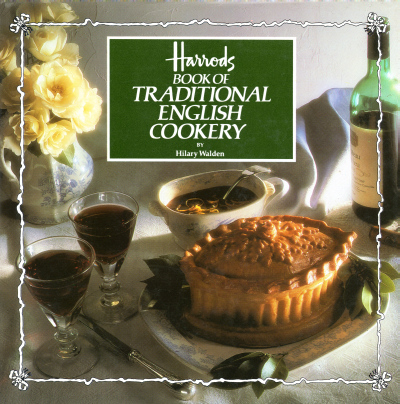Harrods Book of Traditional English Cookery
Another promotional cookbook, from Harrod’s in 1987.
We previously have noted that cookbooks published to promote products or the places that sell them are at best a proverbial mixed bag. One of them, from the Busha Brown sauce people in the Caribbean, occasioned one of our lamentable Pizza Deliveries from the lyrical. Another, however, from 1940 by Henry Sarson of Sarson’s vinegars, has become a favorite of britishfoodinamerica so we profiled it, appropriately enough, in conjunction with an essay on pickling and preserving in our Ninth Number. Most promotionals fall within the bad bad Busha category but some of them are tougher to categorize.
Harrod’s Book of Traditional English Cookery by Hilary Walden is a curious book on a number of levels. The author has written a lot of cookbooks as well as articles for British periodicals but is unknown in the United States. And yet Traditional English Cookery bears a New York imprint despite the fact that it was printed in Italy. The book contains elements of both the bad and the good, but ironically cannot be considered inconsistent for that.
The flyleaf aims at an American audience; Harrod’s is “that quintessentially English store, renowned worldwide for quality and good taste,” and the book “echoes and reflects those qualities.” It is “wonderfully evocative” and “will be cherished and used again and again,” not least because it uses “modern equipment and cooking techniques, and ingredients readily available in American markets.” This sounds at once like excreta from the nostalgia industry and musty ‘progress’ prose from the 1950s, even though Traditional English Cookery appeared in 1987.

The book itself is pretty in the bad Olde England Tea Room way, leading us to expect even worse of the text. Its cursory historical introduction delivers on the promise: It is awful. The tone is authoritative, the content inaccurate and anachronistic. It gives the reader no hope for the recipes that follow.
All of this is unfortunate, not least because by inference it contributes to the American perception of British food as archaic and ridiculous. The recipes therefore are a revelation, because when Traditional English Cookery gets down to business it works. It is not comprehensive, only 94 pages padded out with nice engravings from Harrod’s catalogs past and glossy color food porn, but it may be the best introduction to its subject that the Editor has found. Someone unfamiliar with English foodways but nonetheless serious and studious enough to experiment with them will find accessible recipes thoughtfully chosen and articulated. As advertised on the flyleaf, the recipes are indeed tailored to the United States; measurements are traditional rather than metric, and the ingredients required readily accessible. The explanatory introductions to each recipe are not even that bad.
Nor is the title muddled; the recipes actually originate in England alone, so Traditional English Cooking avoids the usual conflation of the entire archipelago with its most populous nation. Recipes range from the fourteenth to the twentieth century and, we are told, derive from historical manuscripts and publications, all of which unfortunately remain unidentified. Still, the scholarship is impressive. Not many cookbooks include the stew of freshwater fish called water souchy, derived as properly noted from the Flemish ‘waterzootje.’ Virtually no cookbooks, not even the best in the English canon, contain a recipe for fish pudding, and this one’s is good. It even incorporates anchovies as a hidden accent along with other recipes dispersed throughout the book, but unfortunately without explanation why or how the little fermented fish became a cornerstone of English cuisine. Once again, while the history falters the recipes shine; anchovy also properly appears in the book’s recipe for raised pork pie along with bacon in addition to fresh pork and its other essential seasonings of allspice, mace and sage.
Lost good recipes like spiced beef, caudle, lamb stuffed with crab, and parkin share the text with less obscure classics like boiled beef, dressed crab, game pie, steak and kidney pudding with oysters, summer pudding and more. There is a ‘fine salad,’ accurately rendered, from the eighteenth century.
So Traditional English Food is a delightful discovery despite itself, or perhaps despite the efforts of the publication’s marketing crew. On balance this should not have surprised us, for Harrod’s has commissioned some accomplished authors, even including luminaries like Elisabeth Ayrton, Philippa Davenport and Lady MacDonald (“of MacDonald”), to write about cookery throughout the postwar years. Traditional English Food suffers not at all in comparison and has motivated the Editor to seek out the works of Miss Walden, who apparently lives on a houseboat in London.
The little book is out of print but available on the cheap at abebooks.com from the Advanced Book Exchange.

